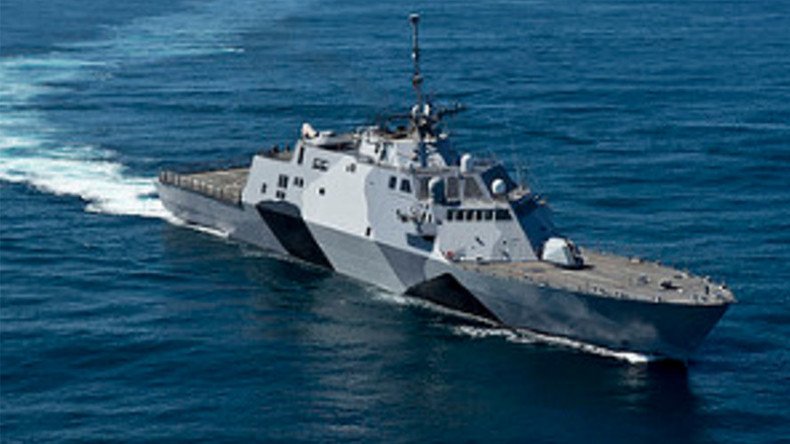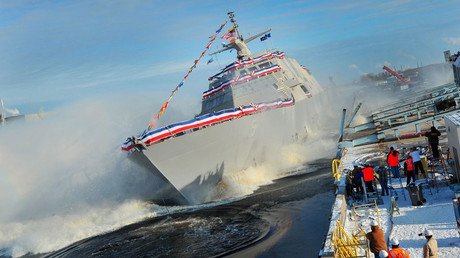The miracle that wasn’t: Navy hammered in Senate over ‘failed’ ship design

The US Navy’s Littoral Combat Ships (LCS) are over budget, far behind schedule and cannot perform any of their designated missions, government auditors told a Senate panel. They are opposed to Navy proposals to buy 12 more ships, re-designated as frigates.
The LCS was supposed to give the surface fleet radical new capabilities in coastal waters, replacing frigates and destroyers in missions ranging from mine-sweeping and antisubmarine operations to surface warfare. Two different designs were approved, with the first ship rolling off the dock in 2008.
Much like the F-35 Joint Strike Fighter, the LCS was supposed to be a modular design, with ships swapping out “mission package equipment” depending on mission requirements. That never happened, and the new ships ended up being less versatile than the frigates they were supposed to replace, according to the testimony of J. Michael Gilmore, director of operational test and evaluation at the Department of Defense.
Navy admits new fleet has 'near-zero chance of completing 30-day mission'... https://t.co/xT2jyEREpA
— DRUDGE REPORT (@DRUDGE_REPORT) December 2, 2016
“I have found no evidence to date that LCS will be effective or survivable even in the scenarios and missions in which it was designed to be successful,” Gilmore told the Senate Armed Services Committee on Thursday.
One variant of the LCS is built by Lockheed Martin – the conglomerate that is also behind the F-35 – with Austal USA providing the other. Both “fall severely short” of the Navy’s reliability requirements, and “have a near-zero chance of completing a 30-day mission” without critical failure, Gilmore testified, adding that the ships are incapable of actually surviving a combat engagement in the environment for which they were designed.
"We’re 26 ships into the contract and we still don’t know if the LCS can do its job." @USGAO's Paul Francis tells SASC
— Caroline Houck (@carolinehouck) December 1, 2016
"The miracle of the LCS didn't happen," said Paul Francis, managing director at the Government Accountability Office. "We are 26 ships into the contract and we still don't know if it can do its job.”
The original plan to build 55 hulls at $220 million each and have them fully capable by 2018 turned into only 8 actual ships delivered by 2016, with anti-submarine, mine-sweeping and missile capabilities still to be achieved. Meanwhile, the cost per ship had increased to $478 million, Francis said.
By 2014, the Navy had abandoned the LCS concept, but is now seeking to buy a dozen more ships re-designated as frigates, with minor modifications to the design. The actual designs have yet to be completed, however.
“A more basic oversight question today is whether a ship that costs twice as much yet delivers less capability than planned warrants an additional investment of nearly $14 billion,” Francis told lawmakers.
The Navy pushed back on criticism, with Assistant Secretary for Acquisition Sean Stackley and Vice Admiral Thomas Rowden, commander of Naval Surface Forces, arguing the ships’ chronic technical issues were growing pains that have been resolved.
“With its shallow draft, great speed, and interchangeable modules, LCS will provide increased warfighting flexibility to our Fleet and close critical warfighting gaps in mine warfare, anti-submarine warfare and surface warfare,” Rowden and Stackley said in their joint testimony. Continuing to build the ships would help maintain the industrial base, they added.
"Haven't we done enough for the industrial base? Isn't it time for the industrial base to come through for us? Can we get one ship delivered on time? Can we get one ship delivered with cost growth? Can we get one ship delivered without serious reliability and quality problems?" Francis said.
The program’s failure “followed predictably from an inability to define and stabilize requirements, unrealistic initial cost estimates, and unreliable assessments of technical and integration risk, made worse by repeatedly buying ships and mission packages before proving they are effective and can be operated together," said Armed Services Chairman John McCain (R-Arizona).
Senator Lindsey Graham (R-South Carolina) likewise remained unconvinced.
“The process is completely broken,” he told the witnesses. “If you want this to stop, somebody needs to get fired.”













